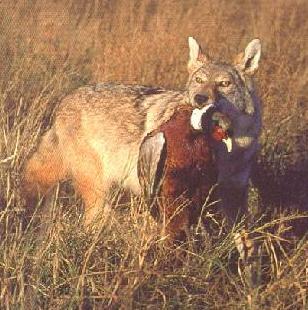The Coyote
Coyote Hunter Home
About the Coyote
Information on Hunting Coyotes
Arkansas Coyote season 2015-2016
Pic's Page
Guest Photos
Sign our Guest Book
X-treme Camo
Favorite Links
My Photos
A Most Cunning Adversary
I became interested in coyotes over ten years ago. I've been hunting them ever since. With each of my encounters with one of these creatures, it becomes more apparent that the coyote is a quick learner. I've been outsmarted by them hundreds of times. SV
The Coyote
Native Americans believe that the coyote also known as the high plains drifter were put on Earth at the time of the first man. If this is true, the coyote has been learning from man since that time.
Originally the coyote roamed the prairies, deserts, and the mountains of the Midwestern United States, unchallenged by man.
However, when humans began to populate the mid-western states, the coyote quickly learned to live in close proximity to them. We must understand that as society becomes urbanized the coyote urbanizes as well.
After being hunted and poisoned to near extinction in the mid 1920's, the coyote began to expand its range East of the Mississippi River.
Today, even though heavily hunted in 49 of the 50 states, they are not endangered and their population is higher than ever. The coyote has adjusted to man's encroachment upon its habitat because of its ability to vary its' diet. Coyotes are omnivores, eating whatever is available. As an opportunist, like all scavengers, the coyote will often feed on road killed and other dead animals, fruit, garbage, even food from your favorite pet's dish.
As a carnivore, coyotes prey on rabbits, rodents, squirrels, and other small mammals.
They are brave in numbers; while hunting in packs, coyotes will often attack larger mammals such as white-tailed deer, livestock, and household pets.
When food supplies are limited or their numbers are threatened in any way, the coyote
possesses a unique reproductive strategy to safeguard against extermination.
Wildlife biologists have observed that coyotes have the ability to genetically manipulate the size of their litters.
The average number of coyote pups ranges from 5 to 7, however; at their own discretion, one female can have up to 12 pups.
As you can see, the coyote has continued to endure against all odds.
Their ability to vary their diet, manipulate the size of their litters and adapt to their environment
insures their survival.
In conclusion, the "song dog", coyote, also known in Native American lore as the "trickster",
prospers when faced with adversity and his howl may very well be the last melody heard on
Earth.
References
Coyote Canis Latrans, http://w3.one.net/~tjones/coyote.htm (15 Oct. 1998).
Track of the Coyote, http://www.wildrockies.org/ActivOrg/PredProj/PPnews/Wintr_96/CoyTrack.html
Originally the coyote roamed the prairies, deserts, and the mountains of the Midwestern United States, unchallenged by man.
However, when humans began to populate the mid-western states, the coyote quickly learned to live in close proximity to them. We must understand that as society becomes urbanized the coyote urbanizes as well.
After being hunted and poisoned to near extinction in the mid 1920's, the coyote began to expand its range East of the Mississippi River.
Today, even though heavily hunted in 49 of the 50 states, they are not endangered and their population is higher than ever. The coyote has adjusted to man's encroachment upon its habitat because of its ability to vary its' diet. Coyotes are omnivores, eating whatever is available. As an opportunist, like all scavengers, the coyote will often feed on road killed and other dead animals, fruit, garbage, even food from your favorite pet's dish.
As a carnivore, coyotes prey on rabbits, rodents, squirrels, and other small mammals.
They are brave in numbers; while hunting in packs, coyotes will often attack larger mammals such as white-tailed deer, livestock, and household pets.
When food supplies are limited or their numbers are threatened in any way, the coyote
possesses a unique reproductive strategy to safeguard against extermination.
Wildlife biologists have observed that coyotes have the ability to genetically manipulate the size of their litters.
The average number of coyote pups ranges from 5 to 7, however; at their own discretion, one female can have up to 12 pups.
As you can see, the coyote has continued to endure against all odds.
Their ability to vary their diet, manipulate the size of their litters and adapt to their environment
insures their survival.
In conclusion, the "song dog", coyote, also known in Native American lore as the "trickster",
prospers when faced with adversity and his howl may very well be the last melody heard on
Earth.
References
Coyote Canis Latrans, http://w3.one.net/~tjones/coyote.htm (15 Oct. 1998).
Track of the Coyote, http://www.wildrockies.org/ActivOrg/PredProj/PPnews/Wintr_96/CoyTrack.html

Hot Tip!!!
Coyotes will often circle, then approach from down wind. Use a Strong cover sent,and keep watch down wind.